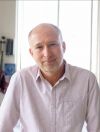NCHIV speaker, Steven Deeks, on how cancer cure may help treat HIV
Steven G. Deeks is a Professor of Medicine at the University of California, San Francisco (UCSF), and an expert on the role of chronic inflammation in untreated and treated HIV disease. At the 10thNetherlands Conference on HIV Pathogenesis, Epidemiology, Prevention and Treatment, Dr Deeks will talk about HIV persistence and its implications for HIV treatment and cure.

I trained in San Francisco in the early 1990s, where essentially half of the people in my hospital were dying from HIV. This was integral to my entire training experience and, while the in-patient work at the time was quite challenging, I was most inspired by the out-patient work. In the out-patient field, I was working with young people who were highly engaged and highly focussed as a community, working with clinicians to come up with ways to tackle the problem. This community-based advocacy, in which clinicians and people with HIV worked closely together, was a new way of practising medicine and has since influenced other parts of medicine. Essentially this opportunity to work with people in a very different way has kept me going for the last 25 years. Today nothing has changed in my job; I was hired to do clinical research and take care of patients, and that’s basically what I still do now.
The subject of your talk at NCHIV will be Persistence of inflammation: implications for treatment and cure. Why is chronic inflammation important?
Chronic inflammation is central to many diseases such as heart disease, chronic inflammatory diseases, chronic gastrointestinal diseases, rheumatological diseases, neurological diseases, cancer etc. It is a central part of our biology that, in a variety of settings, goes awry and contributes to disease. In terms of research into chronic inflammation, there is now a great deal of synergy across all these different fields of medicine, in which we are realising that there’s a central pathway that contributes to poor health and that there are interventions that can reverse this pathway and contribute to better health. That’s what I’m going to talk about at NCHIV in November, illustrating that chronic inflammation is an integral part of many diseases, particularly cancer and HIV, and that we think that the interventions will be quite similar.
What therapeutic interventions are currently being studied to tackle chronic inflammation?
The ultimate goal in controlling HIV is to generate and maintain the killer T cells (CD8+ cells) that can attack the virus. There are a lot of similarities between HIV and cancer. For example, as I mentioned earlier, the inflammatory pathway that contributes to HIV is similar to the inflammatory pathway that contributes to cancer. In both cases, you have a process that starts for different reasons and results in an environment that’s quite harsh and prevents T-cells from working. Today, many of the pathways first discovered in studies of chronic viral infections such as HIV are now being targeted to cure cancer. In cancer, efforts to manipulate the immune pathways in this way have already been quite successful and many cancer patients are now in remission as a result. We hope that a similar approach could work in people living with HIV so that they too could achieve a treatment-free state of remission. The classic example in cancer are the immunotherapies that block PD1. PD1 acts as an immune checkpoint, preventing T-cell production. By blocking the PD1 pathway, these drugs block inflammation and improve T-cell function, as a result of which the T-cells are better able to clear the cancer. We have found that the same pathways, involving PD1, are employed in HIV. So this in an example of a drug in the oncology sphere that we think will potentially help cure people with HIV.
What does your own research focus on?
We have a massive programme with investigators all over the world working under large grants that allows us to work in a multi-institute collaborative manner to understand why inflammation starts, why it persists, how it impacts the immune system and how we can achieve cure. This whole line of research is focussed on figuring out how inflammatory processes contribute to HIV persistence. Of course, other groups, like that of Peter Reiss, are interested in the same pathways in terms of causing ageing and heart disease. In my talk I hope to link all this work in oncology and all this work in ageing to what is happening in an HIV-positive person. My goal is to discuss why the virus persists, why we can’t yet cure people of HIV and why these people appear to have excessive age-associated complications.
This is will be 10th anniversary of the NCHIV meeting. We’ve come a long way in terms of our understanding of HIV. Where do you think we will be another 10 years from now?
I think a cure is going to require a combination approach that tackles different parts of the riddle. However, if, in 10 years, we have come up with a viable, multi-drug intervention that has the capacity to be tested in a large definitive regulatory study, we will have been successful.
Is cure a real possibility?
Absolutely. We’ve already cured one person, Tim Brown, the Berlin patient, and we’ve got close to curing a couple of other people. More importantly, cancer, which we didn’t think was going to be possible to cure, is now becoming much more easy to cure using the same knowledge base as we are applying to HIV.
